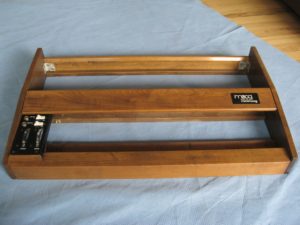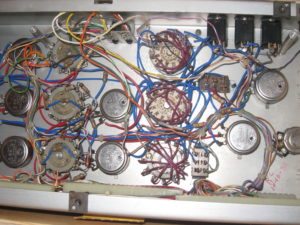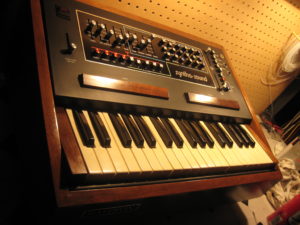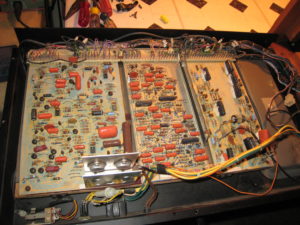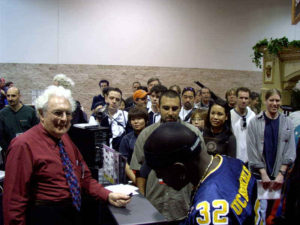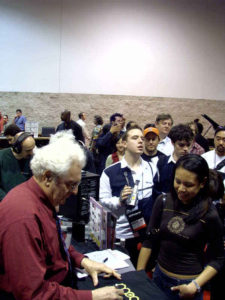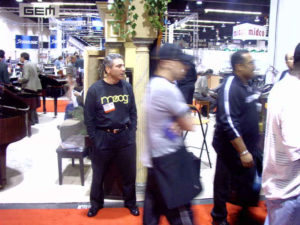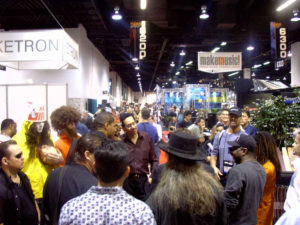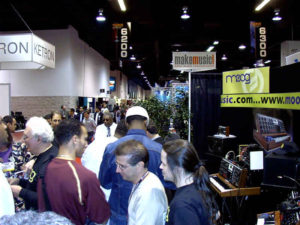Made a analog style sequencer using an Apple II.
It’s equipped with a Mountain Computer ADC / DAC board.
The board can read in 16 channels of voltages.
It can also output 16 channels of voltages.
Voltage ranges are -5 volts to +5 volts.
Resolution is 8 bit whether reading or writing.
Using a blank piece of aluminum panel here, 16 NOS Moog 100K linear pots and some new Cosmo (Moog) knobs, I built a crude 16 stage sequencer within 2 hours.
I also included 16 capacitors that cured a small problem with channel to channel interactivity.
I then programmed a traveling bar graph displaying notes as vertical bars of varying height.
The top of each bar would flash as that particular note played.
All software is written in Applesoft BASIC.
The code was very short.
Making a change such as the choice between V-trig and S-trig outs was one line of code.
Using one of the game paddle inputs, I added a pot for use as tempo.
I also added a gate output jack, along with both a positive CV out channel as well as an inverted CV output jack.
Again, inversion was as easy as adding one line of code.
The sequencer can be run forwards or backwards.
It could be a single channel 16 stage analog sequencer.
Or an 8 stage with variable duration per stage via the second row of 8 pots.
The Apple’s stock cassette jacks could also be programmed to allow syncing the sequencer either to or from an external source, change the direction of the sequence, etc.
In hardware, I plan on adding some opamps to offset the CV out(s) to 0 – 10v instead of -5 to +5 and additional drive capability.
I may also add a gate LED and driver.
In software, I plan on adding variable stage length, duration (as an 8 stage) and a quantizer.
Also a preference page allowing choice of colors for the display and other settings.
A method of changing direction on the fly would be desirable also.
One problem: The bar graph display does not update the note heights until the next cycle of the sequencer. Therefore, changing stages while playing does not show the changes graphically without a considerable delay.
This is me testing out a quickly built 16 stage sequencer using an Apple //e computer.
It only took about 3 hrs to build the panel and write the (pretty crude) software.
LOTS of possibilities to explore in the future though.
The Apple has a Mountain Computer 16 chan ADC / 16 chan DAC.
Everything written in Applesoft BASIC.
The synth is a Moog 55A that’s here for service.
Nothing serious going on here.
Building the sequencer and taking the video were just for fun.
Short story: http://www.youtube.com/watch?v=mRFRFnrNni0
Long story:
I (very quickly) hacked together an analog style sequencer using an Apple II computer equipped with an old Mountain Computer ADC / DAC board.
This board can read in or output 16 channels of analog voltages.
Voltage ranges are -5 volts to +5 volts (though I can change this.)
Resolution is 8 bit, but it’s still fairly accurate hitting note CVs closely.
I made the panel from a piece of scrap aluminum I found here
Used 16 100K linear pots (NOS Moog) and some new Cosmo (Moog style) knobs.
Built and wired it up along with some vinyl lettering in around 2 hrs.
For software, I programmed a traveling bar graph that displays notes as vertical bars of varying height.
The top of each bar would flash as that particular note plays.
One CV out jack is the “normal” mono out.
A 2nd CV out jack is right now programmed as being the same notes, but inverted.
The gate out jack can be whatever- V-trig, S-trig, pulse.
In the video it’s making S-trigs for the Moog 911 envelope generator.
Software is written in Applesoft BASIC.
(Comes built-in on the Apple.)
The code was incredibly short. I couldn’t believe how little it takes to write something like this.
Making any change such as adding a quantizer, variable note durations or sequence length takes about 1 or 2 lines of code.
Right now it’s programmed as a single channel 16 stage analog sequencer with mono CV out.
But I might make it be an 8 stage with the second row of 8 pots changing the duration of the first 8 stages.
A 30+ year old computer driving a 30+ year old synth can still be a lot of fun.
This critter could also be programmed to allow syncing it to or from an external source.
You could even make it go backwards or write a “performance” to disk without too much work.
File date: 12/21/2010




